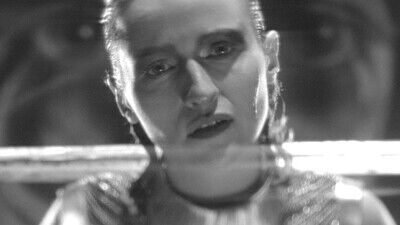Throughout Conann’s multiple incarnations, one character stays consistent. Rainer (Elina Löwensohn)—a tribute to Fassbinder? Wouldn’t be surprising—is a perverse dog-faced oracle in a studded leather jacket who follows Conann all of her life, documenting her with his Instamatic camera and delivering some of the film’s juiciest lines. (“Blessed are the necrophiles, never betrayed by their love,” he remarks, surveying a pile of corpses left in warrior Conann’s wake.) Rainier serves as narrator, taskmaster, and all the Christmas ghosts wrapped up into one, reminding Conann of her commitment to barbarism (i.e., hatred and violence) and making sure she evolves when she needs to—even when she wants to stay still.
In this film, “barbarism” is a female trait. Rainer is the film’s only major male character, and he’s played by a woman, Mandico regular Löwensohn. So it follows that the film’s free-flowing sexuality is Sapphic in nature: One of Conann’s phases is dominated by her all-consuming love affair with Sanja (Julia Riedler), name slightly altered but still red. Beyond the textual lesbianism, however, “Conann” is more broadly queer-coded. There’s the glitter, of course, and all of the tall, sculpted women with broadswords. But the rough edges on the film’s fantasy aesthetic—it’s elevated above DIY, but not quite studio-level polished—also lend it an outsider feel that places it in the firmament of queer art.
The production design, by Anna Le Mouël—a first-time collaborator with Mandico who also worked on “Saint Omer” and “Orlando: My Political Biography”—goes through phases as well. Early scenes are full of long, tangled hair, gorilla-like fursuits, and ragged fake snow, while Conann and Sanja’s NYC apartment epitomizes the “cocaine decor” look. The cinematography is also changeable, switching from black-and-white to color when Mandico and Nicolas Eveilleau—who’s worked with Mandico for years, but steps into the cinematographer role here—deem it appropriate.

